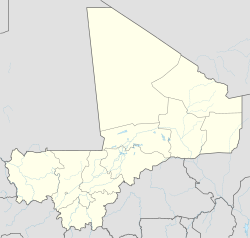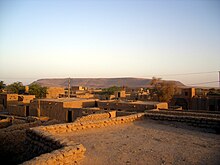Goundam
| Goundam | ||
|---|---|---|
|
|
||
| Coordinates | 16 ° 25 ′ N , 3 ° 40 ′ W | |
| Basic data | ||
| Country | Mali | |
| Timbuktu | ||
| circle | Goundam | |
| ISO 3166-2 | ML-6 | |
| height | 270 m | |
| Residents | 16,253 (2009) | |
| politics | ||
| mayor | Oumou Sall Seck | |

Goundam is a city in northern Mali in the Timbuktu region . It is the capital of Goundam County . With a population of 16,253, it is the third largest city in the region.
location
The city lies on a northwestern branch of the Niger Inland Delta and is traversed by the Marigot de Goundam. This tributary of the Niger supplies the lakes of the Faguibine lake system with water from Niger during floods. It is formed from the two arms of the Tassakant and Kondi rivers, which branch off from the Niger at Bourem and Koriomé, respectively. The floodplain east of Goundam is called Kessou. The city of Diré on the Niger is 35 km southeast, Timbuktu is about 100 km east-northeast. The lakes Lac Fati and Lac Oro are in the southwest near Goundam Airport . Lac Télé begins on the northern edge of the city . The lakes Takara , Gober , Faguibine and Kanango adjoin these in a northerly direction. The area is traversed by mountain chains that protrude 100 to 150 m above the plateau area and run in a north-south direction. One of these mountains, the Bankoré, is located about 3 km north of the city.
history
Goundam has a long history as a center for the agricultural Songhai and fishing Bozo , as well as for sedentary parts of the semi-nomadic Fulani , Tuareg and Moors . Goundam was a city in the Songhai Empire and fell to the Moors when it fell in 1591. It was later taken over by the Tuareg from the northeast and the Fulbe from the Massina region. The most powerful of the Fulbe states at that time was the Macina Empire in the southwest. The Toucouleur Empire conquered the area in the mid-19th century. The French took the city in 1894 with the Collone Joffre.
Goundam was the scene of a brief setback for the French advance into Timbuktu. In the incident known at the time as the " Goundam Massacre " in December 1893, the French first lieutenant Eugene Bonnier and a small troop traveled downriver from the French post in Segou to conquer Timbuktu. His vanguard of only two gunboats under the command of Lieutenant H. Gaston Boiteaux drove ahead, but pushed against the orders to Timbuktu in order to forestall Bonnier. Bonnier pursued him and found that Boiteau had conquered the fabled city before he did, who did not arrive until January 10, 1894. After arresting his subordinate, Bonnier marched towards Goundam with a small number of African soldiers. They took the city on January 14th. On the way they had taken about 500 sheep from a Tuareg camp and had to fight off a Tuareg attack in nearby Tacoubao. In the morning hours of January 15, the Tuareg attacked Bonnier's camp and killed him, 11 officers, 2 French civilians, 68 African auxiliaries and the translator. A rescue expedition led by Joseph Jacques Joffre retook Goundam on February 8 and Timbuktu four days later.
In the aftermath of the drought in the Sahel in the 1970s and again after the Tuareg rebellion in the 1990s, Goundam became an important port of call for Tuareg and other refugees from northern Mali. Many of them continue to live around the city of Goundam.
Attractions
One of the city's landmarks is the adobe Goundam Tokossel Mosque .
Agriculture
The temporarily flooded lakes and natural canals ( marigots ) around Goundam are agrarian favored areas in a landscape north of the agronomic dry line. The hydrological system has suffered from increasing siltation since the drought disasters of the 1970s and 1980s , which has resulted in clogged tributaries and the loss of cultivated land. The low annual rainfall of 200–250 mm allows only limited, unreliable rain-fed agriculture. There are also structural problems such as obsolete seeds and unclear and unfavorable land tenure conditions. The size of the arable land varies greatly from year to year, depending on the level of flooding. The main crop is still millet, although rice is the main food today. Small-scale, market-oriented cultivation of vegetables and fruit takes place on the banks of the canals.
literature
- Pascal James Imperato: Historical Dictionary of Mali . Scarecrow Press, Metuchen / NJ, London 1986, ISBN 0810813696
Web links
- Satellite photos of Goundam, Mali (16 25 03N / 003 40 04W) . Brian J. McMorrow 1999-2005.
- Images and Reports from Federal Government of Germany's "Mali-Nord" program in Goundam (2002) .
- Goundam data at Falling Rain Genomics
Individual evidence
- ↑ INSTAT: Results of the 2009 census (PDF; 815 kB)
- ↑ http://www.tagesschau.de/ausland/mali422.html ( Memento from January 27, 2013 in the Internet Archive )
- ↑ Tombouctou: largest cities and towns and statistics of their population ( Memento of the original from June 15, 2009 in the Internet Archive ) Info: The archive link has been inserted automatically and has not yet been checked. Please check the original and archive link according to the instructions and then remove this notice. . World Gazetteer.
- ↑ Imperato, p. 154
- ^ Imperato, pp. 101-102
- ↑ MSF nutritional care: Goundam camp ( Memento of the original from August 7, 2009 in the Internet Archive ) Info: The archive link was automatically inserted and has not yet been checked. Please check the original and archive link according to the instructions and then remove this notice. . Mickael Therer (2005)
- ↑ Goundam-Tokossel Mosque ( Memento of the original from August 5, 2011 in the Internet Archive ) Info: The archive link was automatically inserted and not yet checked. Please check the original and archive link according to the instructions and then remove this notice. , ArchNet Digital Library.
- ↑ The System of Rice Intensification (SRI) - First Experiences from Timbuktu - Mali / Farmer-led SRI test in Goundam - 2007/2008 (PDF; 4.50 MB). Africare, GFSI Project at Cornell University (2008).


